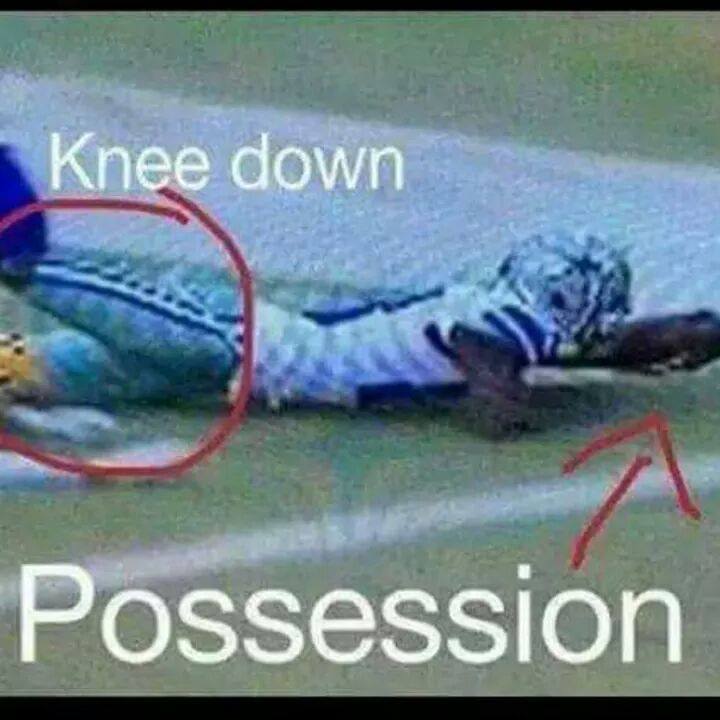BlindFaith
Well-Known Member
- Messages
- 5,250
- Reaction score
- 2,727
My answer BF is common sense. It is really just that simple. Possession of the football in bounds. Discussion over.
Dez got both feet down, shifted the ball from 2 hands to 1 (again, cannot be done without complete control of the football. 100% impossible.), This is possession. It has been since the forward pass cam about. So go all the way back to Red Grange if you need to. He then got another foot down and dove, knee hit the ground, elbow hit the ground. Down by contact or down at the point where the football was when knee and/or elbow hit. And most of all irrefutable proof. Otherwise you CANNOT overturn the call on the field.Al the goofed up language in the world doesn't erase that hard, fast rule. And they ignored it.
Your interpretation of the rules, their interpretation of rules, or mine are all irrelevant. He had possession. This cannot be refuted.
Did you read the info I posted? The history of the catch rule.
I couldn't find a copy of the rulebook/casebook from anytime prior to 2007. But apparently there was language of having to perform an act common to the game. To complete a pass. But nothing really about what that means in regards to going to the ground.
Then in 2007 they removed that to "simplify" things. This is actually the Calving Johnson rule. Removing this language now forced the player to maintain possession through contacting the ground. So do you want to go back to this time? Or back to prior?
Now in 2011, because of catches that looked liked catches weren't being called, they added back in "Become a Runner". But that basically put us where we were prior to 2007.
So our current rule is basically the rule it has been since 2007. They've tried to clarify it, but have failed miserably. At least to those who really don't know what the rule is and why it is.
The real problem is that the NFL has been focused on trying to establish when a player can run with the ball. A runner. In looking through what past rulebooks I could find, they define what a catch is. They define a runner. A passer.
They try to shoehorn in all activities into really, a passer and a runner. The problem is that there really is another piece, the receiver.
The language has changed to try to clarify at what point a player who is attempting to secure control of a pass becomes a runner. When the player is upright, its fairly easy and we all agree, I think, with how that's being officiated today. The real issue is trying to identify how a player who is falling can become a runner. To me, they shouldn't. A player going to the ground does not have the ability to do everything that an upright player can. And the things that they can do are things that put them much more at risk regarding losing the ball. This is the point the NFL as been trying to tightrope on. Fumbles vs catches.
Now, if they clearly distinguished the act of attempting to catch a ball while going to the ground from the act of catching the ball while upright, I think it would help. They have started doing just that. But the rule itself is still not clear. The case plays, at least 2 of the 3 are clear though. Regain balance or brace. The other more vague case play says time. And because they have lumped a runner with a receiver, that opens up the confusion that all a receiver should have to do is anything that a runner has to do. But this is not what the direction is or has been of what the NFL intended the rule to mean.
They could leave the rules exactly as is for an upright player. Just make a new rule for a player going to the ground. Come up with the catch process rules.
1. Possession of the ball
2. Two feet down
3. This is the one for debate and has everyone up in arms about. But all they need to do is clearly state what a player can do to complete the process. Maybe its just as simple as its a catch as soon as another body part touches the ground. That will clearly cause all kinds of fumbles and controversy as well, but all of these catches that look like catches that aren't would be ruled complete. If that's what everyone wants. Then, when contacting the ground and the ball comes loose, its' only a fumble if the player had not been contacted by another player. Another part to have to consider would be boundary catches. You would have to keep in the going to the ground rule as is, unless you just say that all they need to do is get another body part down as well. But now that body part would be out of bounds.
That would be the simple fix. But I guarantee that there will be a call at some point that everyone freaks out about with even this simplification. Thats why this rule has gone back and forth, clarified, amended, refined and...misunderstood.
It would be nice if they really gave long and hard thought to this. Radically change the rules if need be. Be crystal clear on all the scenarios. But get it right and be done with it. At least for a few years until the next outcry.




